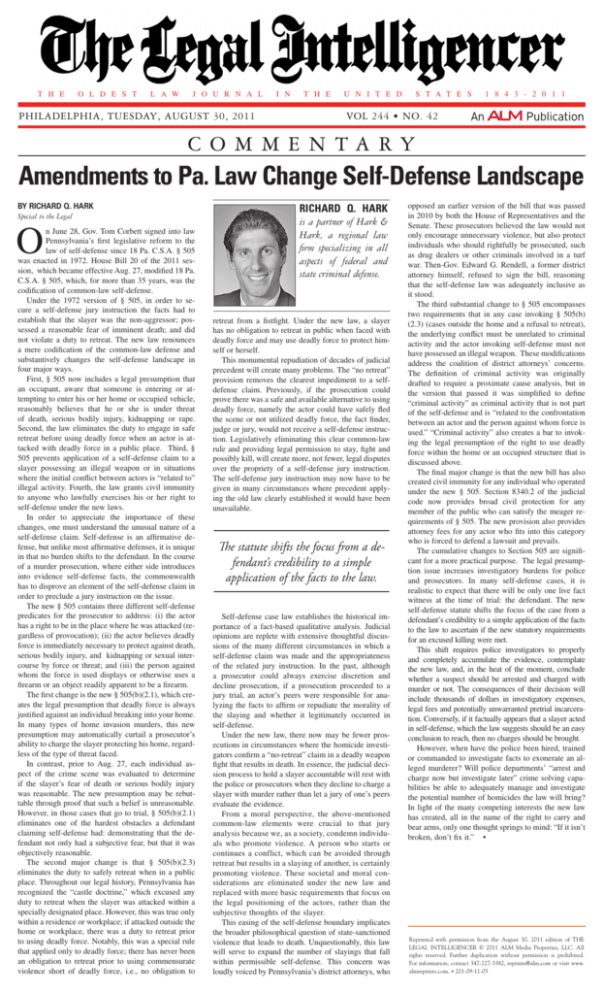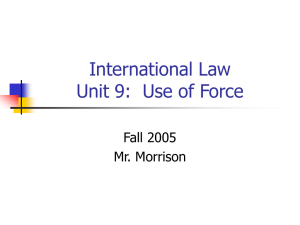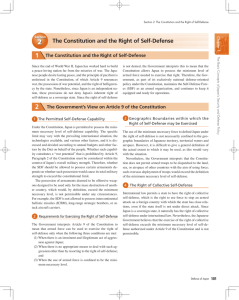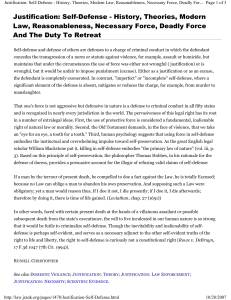
T h e
O l d e s t
L a w
J o u r n a l
philadelphia, Tuesday, August 30, 2011
i n
t h e
U n i t e d
St a t e s
1 8 4 3 - 2 0 1 1
VOL 244 • NO. 42
c o m m e n ta ry
Amendments to Pa. Law Change Self-Defense Landscape
By Richard Q. Hark
Special to the Legal
O
n June 28, Gov. Tom Corbett signed into law
Pennsylvania’s first legislative reform to the
law of self-defense since 18 Pa. C.S.A. § 505
was enacted in 1972. House Bill 20 of the 2011 session, which became effective Aug. 27, modified 18 Pa.
C.S.A. § 505, which, for more than 35 years, was the
codification of common-law self-defense.
Under the 1972 version of § 505, in order to secure a self-defense jury instruction the facts had to
establish that the slayer was the non-aggressor; possessed a reasonable fear of imminent death; and did
not violate a duty to retreat. The new law renounces
a mere codification of the common-law defense and
substantively changes the self-defense landscape in
four major ways.
First, § 505 now includes a legal presumption that
an occupant, aware that someone is entering or attempting to enter his or her home or occupied vehicle,
reasonably believes that he or she is under threat
of death, serious bodily injury, kidnapping or rape.
Second, the law eliminates the duty to engage in safe
retreat before using deadly force when an actor is attacked with deadly force in a public place. Third, §
505 prevents application of a self-defense claim to a
slayer possessing an illegal weapon or in situations
where the initial conflict between actors is “related to”
illegal activity. Fourth, the law grants civil immunity
to anyone who lawfully exercises his or her right to
self-defense under the new laws.
In order to appreciate the importance of these
changes, one must understand the unusual nature of a
self-defense claim. Self-defense is an affirmative defense, but unlike most affirmative defenses, it is unique
in that no burden shifts to the defendant. In the course
of a murder prosecution, where either side introduces
into evidence self-defense facts, the commonwealth
has to disprove an element of the self-defense claim in
order to preclude a jury instruction on the issue.
The new § 505 contains three different self-defense
predicates for the prosecutor to address: (i) the actor
has a right to be in the place where he was attacked (regardless of provocation); (ii) the actor believes deadly
force is immediately necessary to protect against death,
serious bodily injury, and kidnapping or sexual intercourse by force or threat; and (iii) the person against
whom the force is used displays or otherwise uses a
firearm or an object readily apparent to be a firearm.
The first change is the new § 505(b)(2.1), which creates the legal presumption that deadly force is always
justified against an individual breaking into your home.
In many types of home invasion murders, this new
presumption may automatically curtail a prosecutor’s
ability to charge the slayer protecting his home, regardless of the type of threat faced.
In contrast, prior to Aug. 27, each individual aspect of the crime scene was evaluated to determine
if the slayer’s fear of death or serious bodily injury
was reasonable. The new presumption may be rebuttable through proof that such a belief is unreasonable.
However, in those cases that go to trial, § 505(b)(2.1)
eliminates one of the hardest obstacles a defendant
claiming self-defense had: demonstrating that the defendant not only had a subjective fear, but that it was
objectively reasonable.
The second major change is that § 505(b)(2.3)
eliminates the duty to safely retreat when in a public
place. Throughout our legal history, Pennsylvania has
recognized the “castle doctrine,” which excused any
duty to retreat when the slayer was attacked within a
specially designated place. However, this was true only
within a residence or workplace; if attacked outside the
home or workplace, there was a duty to retreat prior
to using deadly force. Notably, this was a special rule
that applied only to deadly force; there has never been
an obligation to retreat prior to using commensurate
violence short of deadly force, i.e., no obligation to
Richard Q. Hark
is a partner of Hark &
Hark, a regional law
firm specializing in all
aspects of federal and
state criminal defense.
retreat from a fistfight. Under the new law, a slayer
has no obligation to retreat in public when faced with
deadly force and may use deadly force to protect himself or herself.
This monumental repudiation of decades of judicial
precedent will create many problems. The “no retreat”
provision removes the clearest impediment to a selfdefense claim. Previously, if the prosecution could
prove there was a safe and available alternative to using
deadly force, namely the actor could have safely fled
the scene or not utilized deadly force, the fact finder,
judge or jury, would not receive a self-defense instruction. Legislatively eliminating this clear common-law
rule and providing legal permission to stay, fight and
possibly kill, will create more, not fewer, legal disputes
over the propriety of a self-defense jury instruction.
The self-defense jury instruction may now have to be
given in many circumstances where precedent applying the old law clearly established it would have been
unavailable.
The statute shifts the focus from a defendant’s credibility to a simple
application of the facts to the law.
Self-defense case law establishes the historical importance of a fact-based qualitative analysis. Judicial
opinions are replete with extensive thoughtful discussions of the many different circumstances in which a
self-defense claim was made and the appropriateness
of the related jury instruction. In the past, although
a prosecutor could always exercise discretion and
decline prosecution, if a prosecution proceeded to a
jury trial, an actor’s peers were responsible for analyzing the facts to affirm or repudiate the morality of
the slaying and whether it legitimately occurred in
self-defense.
Under the new law, there now may be fewer prosecutions in circumstances where the homicide investigators confirm a “no-retreat” claim in a deadly weapon
fight that results in death. In essence, the judicial decision process to hold a slayer accountable will rest with
the police or prosecutors when they decline to charge a
slayer with murder rather than let a jury of one’s peers
evaluate the evidence.
From a moral perspective, the above-mentioned
common-law elements were crucial to that jury
analysis because we, as a society, condemn individuals who promote violence. A person who starts or
continues a conflict, which can be avoided through
retreat but results in a slaying of another, is certainly
promoting violence. These societal and moral considerations are eliminated under the new law and
replaced with more basic requirements that focus on
the legal positioning of the actors, rather than the
subjective thoughts of the slayer.
This easing of the self-defense boundary implicates
the broader philosophical question of state-sanctioned
violence that leads to death. Unquestionably, this law
will serve to expand the number of slayings that fall
within permissible self-defense. This concern was
loudly voiced by Pennsylvania’s district attorneys, who
opposed an earlier version of the bill that was passed
in 2010 by both the House of Representatives and the
Senate. These prosecutors believed the law would not
only encourage unnecessary violence, but also protect
individuals who should rightfully be prosecuted, such
as drug dealers or other criminals involved in a turf
war. Then-Gov. Edward G. Rendell, a former district
attorney himself, refused to sign the bill, reasoning
that the self-defense law was adequately inclusive as
it stood.
The third substantial change to § 505 encompasses
two requirements that in any case invoking § 505(b)
(2.3) (cases outside the home and a refusal to retreat),
the underlying conflict must be unrelated to criminal
activity and the actor invoking self-defense must not
have possessed an illegal weapon. These modifications
address the coalition of district attorneys’ concerns.
The definition of criminal activity was originally
drafted to require a proximate cause analysis, but in
the version that passed it was simplified to define
“criminal activity” as criminal activity that is not part
of the self-defense and is “related to the confrontation
between an actor and the person against whom force is
used.” “Criminal activity” also creates a bar to invoking the legal presumption of the right to use deadly
force within the home or an occupied structure that is
discussed above.
The final major change is that the new bill has also
created civil immunity for any individual who operated
under the new § 505. Section 8340.2 of the judicial
code now provides broad civil protection for any
member of the public who can satisfy the meager requirements of § 505. The new provision also provides
attorney fees for any actor who fits into this category
who is forced to defend a lawsuit and prevails.
The cumulative changes to Section 505 are significant for a more practical purpose. The legal presumption issue increases investigatory burdens for police
and prosecutors. In many self-defense cases, it is
realistic to expect that there will be only one live fact
witness at the time of trial: the defendant. The new
self-defense statute shifts the focus of the case from a
defendant’s credibility to a simple application of the facts
to the law to ascertain if the new statutory requirements
for an excused killing were met.
This shift requires police investigators to properly
and completely accumulate the evidence, contemplate
the new law, and, in the heat of the moment, conclude
whether a suspect should be arrested and charged with
murder or not. The consequences of their decision will
include thousands of dollars in investigatory expenses,
legal fees and potentially unwarranted pretrial incarceration. Conversely, if it factually appears that a slayer acted
in self-defense, which the law suggests should be an easy
conclusion to reach, then no charges should be brought.
However, when have the police been hired, trained
or commanded to investigate facts to exonerate an alleged murderer? Will police departments’ “arrest and
charge now but investigate later” crime solving capabilities be able to adequately manage and investigate
the potential number of homicides the law will bring?
In light of the many competing interests the new law
has created, all in the name of the right to carry and
bear arms, only one thought springs to mind: “If it isn’t
broken, don’t fix it.” •
Reprinted with permission from the August 30, 2011 edition of The
Legal Intelligencer © 2011 ALM Media Properties, LLC. All
rights reserved. Further duplication without permission is prohibited.
For information, contact 347-227-3382, reprints@alm.com or visit www.
almreprints.com. # 201-09-11-05








